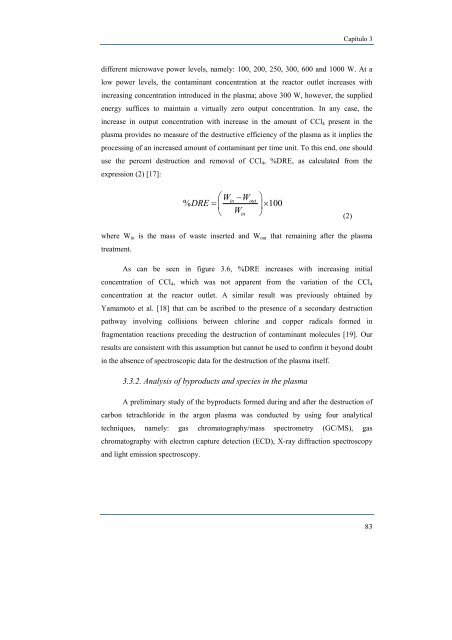estudio y caracterización de un plasma de microondas a presión ...
estudio y caracterización de un plasma de microondas a presión ...
estudio y caracterización de un plasma de microondas a presión ...
Create successful ePaper yourself
Turn your PDF publications into a flip-book with our unique Google optimized e-Paper software.
Capítulo 3<br />
different microwave power levels, namely: 100, 200, 250, 300, 600 and 1000 W. At a<br />
low power levels, the contaminant concentration at the reactor outlet increases with<br />
increasing concentration introduced in the <strong>plasma</strong>; above 300 W, however, the supplied<br />
energy suffices to maintain a virtually zero output concentration. In any case, the<br />
increase in output concentration with increase in the amo<strong>un</strong>t of CCl4 present in the<br />
<strong>plasma</strong> provi<strong>de</strong>s no measure of the <strong>de</strong>structive efficiency of the <strong>plasma</strong> as it implies the<br />
processing of an increased amo<strong>un</strong>t of contaminant per time <strong>un</strong>it. To this end, one should<br />
use the percent <strong>de</strong>struction and removal of CCl4, %DRE, as calculated from the<br />
expression (2) [17]:<br />
⎛Win −W<br />
⎞ out<br />
% DRE = ⎜ ⎟×<br />
100<br />
⎝ Win<br />
⎠ (2)<br />
where Win is the mass of waste inserted and Wout that remaining after the <strong>plasma</strong><br />
treatment.<br />
As can be seen in figure 3.6, %DRE increases with increasing initial<br />
concentration of CCl4, which was not apparent from the variation of the CCl4<br />
concentration at the reactor outlet. A similar result was previously obtained by<br />
Yamamoto et al. [18] that can be ascribed to the presence of a secondary <strong>de</strong>struction<br />
pathway involving collisions between chlorine and copper radicals formed in<br />
fragmentation reactions preceding the <strong>de</strong>struction of contaminant molecules [19]. Our<br />
results are consistent with this assumption but cannot be used to confirm it beyond doubt<br />
in the absence of spectroscopic data for the <strong>de</strong>struction of the <strong>plasma</strong> itself.<br />
3.3.2. Analysis of byproducts and species in the <strong>plasma</strong><br />
A preliminary study of the byproducts formed during and after the <strong>de</strong>struction of<br />
carbon tetrachlori<strong>de</strong> in the argon <strong>plasma</strong> was conducted by using four analytical<br />
techniques, namely: gas chromatography/mass spectrometry (GC/MS), gas<br />
chromatography with electron capture <strong>de</strong>tection (ECD), X-ray diffraction spectroscopy<br />
and light emission spectroscopy.<br />
83

















